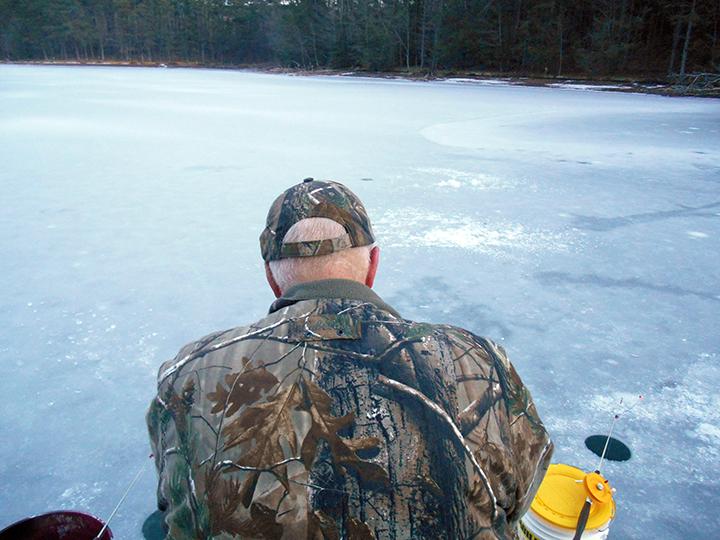 |
|
| Issue #91 • January/February, 2005 |
Only thing hard about hard water fishing is the ice. Once you’ve broken through that obstacle, the rest is easy gliding. Ice fishing is great sport for the whole family and there’s good news: You don’t have to take out a loan to outfit your party, regardless of number, since novice gear is pretty basic stuff.
|
In order to enjoy brisk days on frozen lakes, you need to be dressed properly, as nothing ruins fun faster than chattering teeth. Warm winter boots, proven waterproof, are a must as sometimes lakes are slushy. Follow the old “dress in layers” rule which allows peeling when too hot. Regardless of what’s underneath, your outer layer is most important and should be insulated, water and wind proof. Top with wool caps or toques and enough mitts to go around twice. Goggles protect eyes against blustery winds and sun glasses should be worn on bright days when lakes are glare.
Breaking the obstacle
When I was a kid, dad would cuss a blue streak while chiseling holes in our backyard lake with a primitive tool known as a spud. Once opened, we guarded the holes from freezing over by covering with layers of cardboard and snow when not in use. You’ll be able to hack a family’s worth of holes with an ice chisel in early winter when ice is relatively thin (see guidelines for safe ice) but as the season progresses and ice grows to depths of a foot or more, the job with a spud becomes a dreadful thought.
|
An ice auger is a fascinating tool that no space-age fisherman should be without, for it drills holes quickly with ease allowing freedom to test the whole lake rather than being confined to one spot. Manual augers are least expensive models but you can go all out with smooth-cutting power tools that bore up to 10-inch holes through two-foot ice with amazing speed.
Here’s something to smile about: When it comes to rods, you can go without, for in the old days almost everyone used willow twigs and I can vouch they work fine. If you’re crafty, you can recycle a broken fly or light spinning rod tip into an ice rod, for it only needs to be about a quarter the length of a regular pole. Refit the handle or plop on a cork and you’ve got it made. There are inexpensive contraptions called tip-ups for ice fishing or better yet, outfit the gang with store-bought ice rods and you’ll still be smiling since they are surprisingly reasonable compared to other types of rods.
You’ll need line
Black braided line used to be the norm, but today monofilament line is more popular. When fishing smaller or stocked lakes with average-sized populations, you can go with lighter tests. For larger lakes with bigger possibilities, increase test accordingly. If word has it that monsters inhabit the lake, use line that’ll pass the test.
|
If you don’t have a tackle box full of basics, get leaders. I like nickel wound with interlock snaps and crane swivels. You’ll need hooks and sinkers. When choosing hook size remember the old saying: it’s easier to catch a big fish on a small hook than a small fish on a big hook. You’ll also need a dipper or skimmer for keeping holes free of ice buildup, a fish bonker to put down keepers, and a basket to hold and carry catch. Most importantly, ensure everyone in your party who requires one by law, pockets a valid fishing license.
So what tickles the appetite of fish under ice? In lakes where I’ve had warm weather luck with worms, I’ve had winter luck as well. Same seems to holds true for other bait. Most tackle shops supply worms year-round along with an assortment of appetizers like creel (shrimp) and bottled roe. Be sure to check regulations regarding bait restrictions and read up on quotas, size, and species limits before heading out.
One way to find out what fish in local lakes fancy is to ask your dealer to recommend what’s hot. These folks are tuned in to what’s happening and will be happy to help you make a good selection. Bright, flashy spoons and lures that offer lively action when jigged (worked up and down to attract fish) are sure bets. There’s tons of tackle like scented power bait, lures that glow under water, and synthetic worms and minnows that “swim” like the real thing, so let your partners have fun helping to choose. Of course, nothing beats striking up a conversation with other fishermen to see what they’ve been having luck with.
Where to drill
In early winter under first ice, rainbow and brook trout in smaller, stocked waters are noted for hanging out in shallows in search of feed. Fishing the shoreline with worms, creel, or roe is the way to go. As ice thickens fish are forced into deeper realms.
|
Larger trout are roamers and in bigger lakes can be found in middle depths in earlier parts of the season, moving down as ice grows. River inlets where incoming oxygenated water carries and churns up food are promising spots. Bays, points, or islands with sudden drop-offs are interesting places to check for activity and nothing attracts quicker than jigging a flashy lure.
Any lure with good action is worth trying when the goal is a predacious fish with a ravenous appetite like lake trout. Deep-dwelling char need lots of coaxing with big colorful spoons. Smaller-mouthed whitefish fancy worms and roe above all else. If you’re targeting burbot, which bite best in late afternoon, fish the mud where they will be rooting along with suckers and other bottom feeders.
Patterns vary from lake to lake due to cover, oxygen, weather, food, and fishing traffic, so hot spots are only hot when you find them. Some swear calm, overcast days are more prospective than windy days with bright sun. It’s said that deep water fish see best during bright sun and shallow dwellers have better vision in early and late afternoon light. I figure fish strike when they’re hungry and like any mode of angling, success depends heavily on patience and luck.
When testing your luck with a baited hook, drop your sinkered line to the bottom. Wind in to the desired starting depth and secure. Plant twig, rod, or tip-up firmly in the snow with tip centered directly over hole so line is not rubbing on ice which can cause wearing. You can attach a little bell to alert nibbling or watch the flag on your tip-up for action. When a fish strikes, you get your chance at catching.
|
If there are no bites at the expected depth, try lowering or raising line. Fish may be hovering a few feet off the bottom or scouring just below the ice surface. Keep exploring depths until you reach action.
Jigging is the most productive method of catching big fish under ice. Any spoon that can be worked to resemble lively minnow action is ideal for jigging. Lower your lure to desired starting depth. Secure the line around your mitten or gloved hand or jig with rod by slowly raising and lowing the lure. Start out by making short, sharp jerks. If this doesn’t generate interest, try swinging the lure back and forth. If you still aren’t drawing attention, alternate action by making exaggerated moveslong, swift pulls followed by shorter, slower ones. This kind of action can be seen underwater for miles. A trick worth trying is to drop a lure to the bottom and work it to stir up mud. This muddy action resembles a bottom-feeder rooting for food. Since bottom feeders often make a trophy’s meal, this trickery could whet the appetite of a prize.
There’s nothing more thrilling than sight-fishingwatching action below ice. The old-fashioned way is to lay on your belly, hood head with a scarf to block light, and peer into the hole to watch fish approaching and see their reaction to your offering. Today you can buy a portable fabric dark house for sight-fishing or build your own. Just take a cardboard box, paint the inside black, cut a hole in the side for your head to fit in, and your ready to roll.
If you want to go high-tech, there are underwater cameras that are truly unbelievable and depth and fish finders that work like a charm. Not to mention portable ice huts with comfy seats, heaters that’ll keep you cozy, sleighs and sleds to tote your gear, and oodles of other newfangled things that lifts a great old sport to exciting new heights.
Whether you go basic or high tech, sharing a thermos of hot chocolate with your loved ones on a snow-sparkling lake is the ultimate pleasure of winter. Fun that’s simply hard to beat.
|
|




















